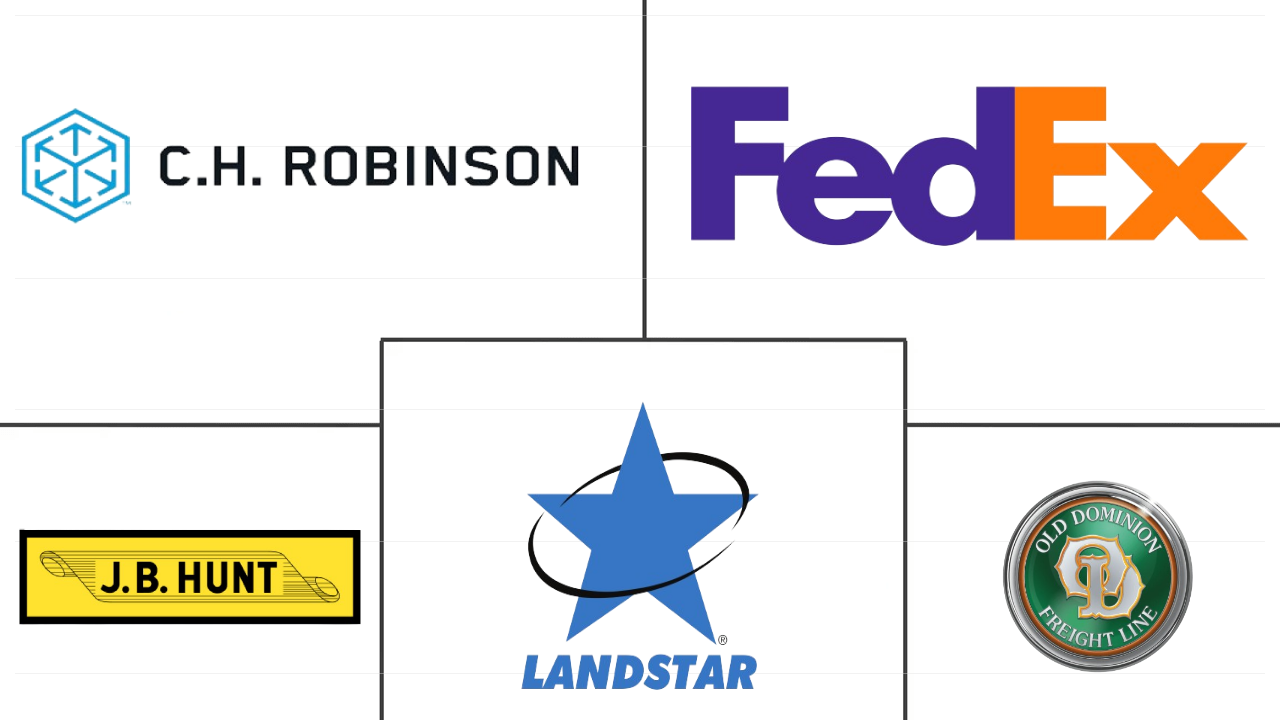Market Size of united states road freight transport Industry
|
|
Study Period | 2017 - 2030 |
|
|
Market Size (2024) | USD 540.96 Billion |
|
|
Market Size (2030) | USD 674.49 Billion |
|
|
Largest Share by End User Industry | Manufacturing |
|
|
CAGR (2024 - 2030) | 3.75 % |
|
|
Fastest Growing by End User Industry | Wholesale and Retail Trade |
Major Players |
||

|
||
|
*Disclaimer: Major Players sorted in no particular order |
United States Road Freight Transport Market Analysis
The United States Road Freight Transport Market size is estimated at 540.96 billion USD in 2024, and is expected to reach 674.49 billion USD by 2030, growing at a CAGR of 3.75% during the forecast period (2024-2030).
540.96 Billion
Market Size in 2024 (USD)
674.49 Billion
Market Size in 2030 (USD)
2.90 %
CAGR (2017-2023)
3.75 %
CAGR (2024-2030)
Largest Market by Distance
72.01 %
value share, Long Haul, 2023
Long-haul trucking is significant in the United States for cross-border freight transport. The United States registered around 17.59% YoY growth in exports and 15.01% YoY growth in imports in 2022.
Largest Market by Goods Configuration
73.64 %
value share, Solid Goods, 2023
The solid goods segment dominates the product type over the liquid goods segment as products involved in the solid goods sector make up a significant portion of the US GDP and trade.
Largest Market by End User Industry
31.33 %
value share, Manufacturing, 2023
The adoption of Industry 4.0 technologies like artificial intelligence (AI), robotics, and automation, driving the growth of the end-user industry in the US.
Fastest Growing Market by Truckload Specification
4.19 %
Projected CAGR, Less than-Truck-Load (LTL), 2024-2030
In the United States, domestic e-commerce held a share of more than 95% as of 2022, which is a significant demand generator for the LTL market.
First Leading Market Player
3.04 %
market share, C.H. Robinson, 2022

C.H. Robinson has been operating in the United States for more than 116 years. The company leases warehouse space of 4.5 million sq. ft in 29 locations, primarily within the United States.
US government investing USD 100 million allocated to 34 projects under the agency's Forest Legacy program
- The U.S. Department of Agriculture introduced the "America Agenda" initiative in 2023, allocating USD 188 million to safeguard vital forestlands. Through 34 projects in the Forest Legacy program, they aim to preserve over 245,000 acres of working forests across 22 states and one island territory. The funding includes USD 100 million from President Biden's Inflation Reduction Act and an extra USD 250 million set for similar conservation efforts the next year. An additional USD 88 million is sourced from the Land and Water Conservation Fund. This investment emphasizes the protection of economically and ecologically important forest areas, focusing on sustainable land use and conservation for the benefit of the nation.
- The construction sector and road freight are closely connected because construction projects rely on transporting materials, equipment, and machinery to and from sites. In the United States, new construction was valued at nearly USD 1.8 trillion, but it's projected to decrease to about USD 1.67 trillion by 2025. Nevertheless, the construction industry has seen consistent growth in recent years, with both residential and non-residential construction spending increasing positively until 2022.
- The oil and gas, mining, and quarrying segment is anticipated to witness significant growth in the future, primarily driven by the initiation of new oil and gas projects. The United States is poised to lead this growth in North America, with approximately 70% of all projects expected to commence operations by 2025. Among these projects, around 83% are categorized as new build projects, and the remaining are expansion projects, predominantly concentrated in the upstream sector.
United States Road Freight Transport Industry Segmentation
Agriculture, Fishing, and Forestry, Construction, Manufacturing, Oil and Gas, Mining and Quarrying, Wholesale and Retail Trade, Others are covered as segments by End User Industry. Domestic, International are covered as segments by Destination. Full-Truck-Load (FTL), Less than-Truck-Load (LTL) are covered as segments by Truckload Specification. Containerized, Non-Containerized are covered as segments by Containerization. Long Haul, Short Haul are covered as segments by Distance. Fluid Goods, Solid Goods are covered as segments by Goods Configuration. Non-Temperature Controlled, Temperature Controlled are covered as segments by Temperature Control.
- The U.S. Department of Agriculture introduced the "America Agenda" initiative in 2023, allocating USD 188 million to safeguard vital forestlands. Through 34 projects in the Forest Legacy program, they aim to preserve over 245,000 acres of working forests across 22 states and one island territory. The funding includes USD 100 million from President Biden's Inflation Reduction Act and an extra USD 250 million set for similar conservation efforts the next year. An additional USD 88 million is sourced from the Land and Water Conservation Fund. This investment emphasizes the protection of economically and ecologically important forest areas, focusing on sustainable land use and conservation for the benefit of the nation.
- The construction sector and road freight are closely connected because construction projects rely on transporting materials, equipment, and machinery to and from sites. In the United States, new construction was valued at nearly USD 1.8 trillion, but it's projected to decrease to about USD 1.67 trillion by 2025. Nevertheless, the construction industry has seen consistent growth in recent years, with both residential and non-residential construction spending increasing positively until 2022.
- The oil and gas, mining, and quarrying segment is anticipated to witness significant growth in the future, primarily driven by the initiation of new oil and gas projects. The United States is poised to lead this growth in North America, with approximately 70% of all projects expected to commence operations by 2025. Among these projects, around 83% are categorized as new build projects, and the remaining are expansion projects, predominantly concentrated in the upstream sector.
| End User Industry | |
| Agriculture, Fishing, and Forestry | |
| Construction | |
| Manufacturing | |
| Oil and Gas, Mining and Quarrying | |
| Wholesale and Retail Trade | |
| Others |
| Destination | |
| Domestic | |
| International |
| Truckload Specification | |
| Full-Truck-Load (FTL) | |
| Less than-Truck-Load (LTL) |
| Containerization | |
| Containerized | |
| Non-Containerized |
| Distance | |
| Long Haul | |
| Short Haul |
| Goods Configuration | |
| Fluid Goods | |
| Solid Goods |
| Temperature Control | |
| Non-Temperature Controlled | |
| Temperature Controlled |
United States Road Freight Transport Market Size Summary
The United States Road Freight Transport Market is poised for steady growth, driven by various sectors such as construction, oil and gas, and international trade. The construction industry, although facing a slight decline in new project valuations, continues to rely heavily on road freight for the transportation of materials and equipment. The oil and gas sector is expected to see significant expansion, with numerous new projects set to commence, further bolstering the demand for road freight services. The intricate transportation and storage infrastructure in the U.S. plays a crucial role in facilitating the movement of goods, supported by strategic federal investments in highways, rail, and port facilities. These investments aim to enhance supply chain reliability and port capacity, which are vital for sustaining the growth of the road freight transport market.
The market is characterized by fragmentation, with major players like C.H. Robinson, FedEx, J.B. Hunt Transport, Inc., Landstar System Inc., and Old Dominion Freight Line holding a significant share. Innovations in technology, such as C.H. Robinson's new scheduling system, are enhancing efficiency in freight shipping. Additionally, companies like Ryder Systems and UPS are expanding their logistics capabilities to meet growing demands in sectors like consumer packaged goods and healthcare. The market's growth is also influenced by fluctuations in fuel prices, with diesel demand recovering rapidly post-pandemic, driven by its essential role in transporting goods and powering various vehicles. Overall, the U.S. road freight transport market is set to experience continued expansion, supported by strategic investments, technological advancements, and sectoral growth.
United States Road Freight Transport Market Size - Table of Contents
-
1. MARKET SEGMENTATION (includes market size in Value in USD, Forecasts up to 2030 and analysis of growth prospects)
-
1.1 End User Industry
-
1.1.1 Agriculture, Fishing, and Forestry
-
1.1.2 Construction
-
1.1.3 Manufacturing
-
1.1.4 Oil and Gas, Mining and Quarrying
-
1.1.5 Wholesale and Retail Trade
-
1.1.6 Others
-
-
1.2 Destination
-
1.2.1 Domestic
-
1.2.2 International
-
-
1.3 Truckload Specification
-
1.3.1 Full-Truck-Load (FTL)
-
1.3.2 Less than-Truck-Load (LTL)
-
-
1.4 Containerization
-
1.4.1 Containerized
-
1.4.2 Non-Containerized
-
-
1.5 Distance
-
1.5.1 Long Haul
-
1.5.2 Short Haul
-
-
1.6 Goods Configuration
-
1.6.1 Fluid Goods
-
1.6.2 Solid Goods
-
-
1.7 Temperature Control
-
1.7.1 Non-Temperature Controlled
-
1.7.2 Temperature Controlled
-
-
United States Road Freight Transport Market Size FAQs
How big is the United States Road Freight Transport Market?
The United States Road Freight Transport Market size is expected to reach USD 540.96 billion in 2024 and grow at a CAGR of 3.75% to reach USD 674.49 billion by 2030.
What is the current United States Road Freight Transport Market size?
In 2024, the United States Road Freight Transport Market size is expected to reach USD 540.96 billion.

